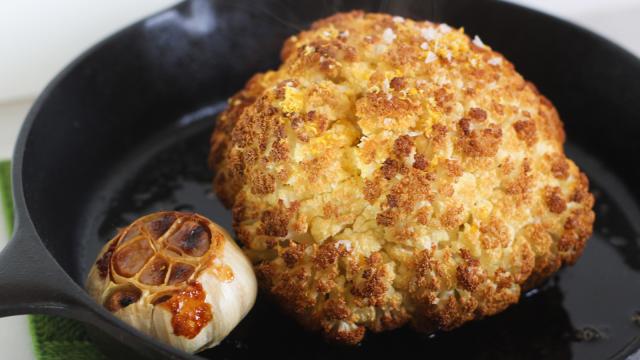Since they do not consume giant, whole birds, vegetarians are often robbed that special, visually arresting main course the meat-eaters enjoy, because meat-eaters can be selfish (apparently).
Obviously, there are many beautiful, delicious dishes you can feed your plant-based friends and family, and one of my favourites is a whole, roasted, beautifully browned cauliflower. When cauliflower is allowed to be itself — and not forced into awkward scenarios where it has to pretend to be pizza crust — it is actually a very good vegetable. As we all know, roasting creates tons of flavour, but to turn your cauliflower into “wow-iflower”, you should brine the sucker, just as you would a turkey.
This practice — which I happened upon while flipping through my life coach’s new cookbook — makes a lot of sense. In the words of Matty Matheson (that would be my life coach), “if you season just the outside, nothing on the inside will have flavour.”
Matty brines his with a simple 10 per cent salt brine, but I took the liberty of inviting a few other friends — such as saffron, garlic, and Meyer lemon zest — to the party. In addition to providing flavour, the brine also provides moisture, which steams the cauliflower while cooking to help it soften. To make your own vegan-friendly, flavorful flower, you will need:
-
1 whole cauliflower, leaves trimmed off
-
1 litre of water
-
100 grams of kosher salt
-
2 tablespoons of sugar
-
1 teaspoon granulated garlic
-
1 teaspoon whole peppercorns
-
1/2 teaspoon saffron threads, crushed between your fingers
-
The zest of 1 Meyer lemon, in strips
-
2 tablespoons of olive oil, plus more for brushing while cooking
Add water, salt, and sugar to a sauce pan and heat until the solutes dissolve. Remove the pan from the heat, add the remaining ingredients, and let everything steep until it comes to room temperature. Place the cauliflower in a bowl, freezer bag, or other cauliflower-sized container, pour the brine over it so it’s completely submerged, then cover (if you’re not using a sealable bag or container), and pop it in the fridge overnight (or for eight daytime hours).
Preheat the oven to 190C. Remove the cauliflower from the brine, and and let it drain, upside down, on paper towels for a few minutes. Flip it over, let it drain a few minutes more, then flip it again and pour one tablespoon of oil into the stems, swirling the cauliflower to distribute.
Place the cauliflower — stem side down — in a cast iron pan (or some other roasting vessel), and drizzle the flower side with the other tablespoon of oil, using a pastry brush (or your fingers) to make sure it’s coated. (There’s no need to salt more here—it’s thoroughly seasoned.)
Pop it in the oven (and throw a head of garlic in there while you’re at it), brushing with more olive oil every half hour, until it is easily pierced with a knife, about an hour and a half to two hours, depending on the size.
If you are using a convection oven, it will brown quite quickly, and you may to cover it with foil halfway through. If you are not using a convection oven, it will not brown as well, and you may need to broil it for a few minutes at the end to get the colour you want.
Let cool a couple of minutes, and sprinkle on some citrus zest and your finest flaky salt before slicing into planks and smearing with roasted garlic. Serve with gravy, some sort of whipped goat cheese, or an herby pesto situation.

Comments